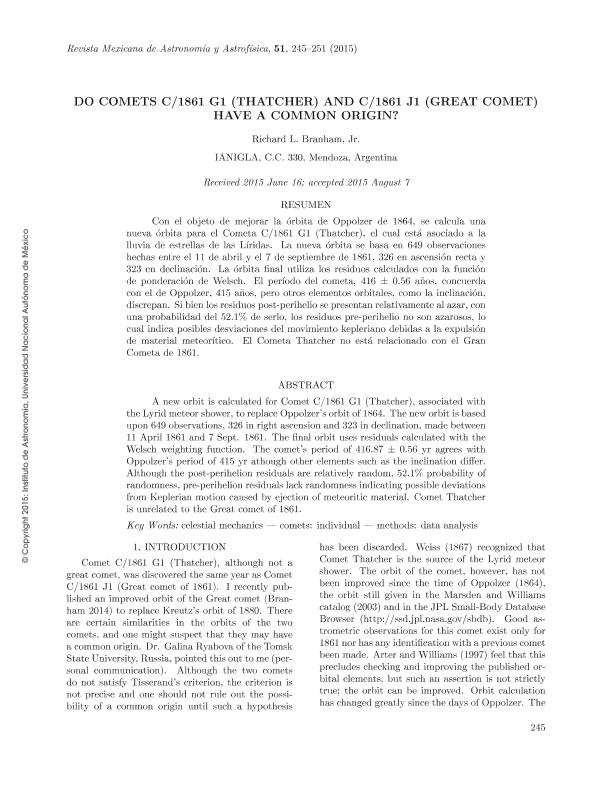Artículo
A new orbit is calculated for Comet C/1861 G1 (Thatcher), associated withthe Lyrid meteor shower, to replace Oppolzer?s orbit of 1864. The new orbit is basedupon 649 observations, 326 in right ascension and 323 in declination, made between11 April 1861 and 7 Sept. 1861. The final orbit uses residuals calculated with theWelsch weighting function. The comet?s period of 416.87 ± 0.56 yr agrees withOppolzer?s period of 415 yr athough other elements such as the inclination differ.Although the post-perihelion residuals are relatively random, 52.1% probability ofrandomness, pre-perihelion residuals lack randomness indicating possible deviationsfrom Keplerian motion caused by ejection of meteoritic material. Comet Thatcheris unrelated to the Great comet of 1861. Con el objeto de mejorar la órbita de Oppolzer de 1864, se calcula una nueva órbita para el Cometa C/1861 G1 (Thatcher), el cual está asociado a la lluvia de estrellas de las Líridas. La nueva órbita se basa en 649 observaciones hechas entre el 11 de abril y el 7 de septiembre de 1861, 326 en ascensión recta y 323 en declinación. La órbita final utiliza los residuos calculados con la función de ponderación de Welsch. El período del cometa, 416 ± 0.56 años, concuerda con el de Oppolzer, 415 años, pero otros elementos orbitales, como la inclinación, discrepan. Si bien los residuos post-perihelio se presentan relativamente al azar, con una probabilidad del 52.1% de serlo, los residuos pre-perihelio no son azarosos, lo cual indica posibles desviaciones del movimiento kepleriano debidas a la expulsión de material meteorítico. El Cometa Thatcher no está relacionado con el Gran Cometa de 1861.
Do comets C/1861 G1 (Thatcher) and C/1861 J1 (Great Comet) have a common origin?
Fecha de publicación:
10/2015
Editorial:
Universidad Nacional Autónoma de México
Revista:
Revista Mexicana de Astronomía y Astrofísica
ISSN:
0185-1101
Idioma:
Inglés
Tipo de recurso:
Artículo publicado
Clasificación temática:
Resumen
Palabras clave:
Celestial Mechanics
,
Comets: Individual
,
Methods: Data Analysis
Archivos asociados
Licencia
Identificadores
Colecciones
Articulos(IANIGLA)
Articulos de INST. ARG. DE NIVOLOGIA, GLACIOLOGIA Y CS. AMBIENT
Articulos de INST. ARG. DE NIVOLOGIA, GLACIOLOGIA Y CS. AMBIENT
Citación
Branham, Richard Lacy; Do comets C/1861 G1 (Thatcher) and C/1861 J1 (Great Comet) have a common origin?; Universidad Nacional Autónoma de México; Revista Mexicana de Astronomía y Astrofísica; 51; 2; 10-2015; 245–251
Compartir




